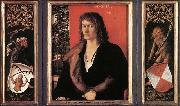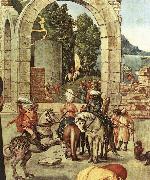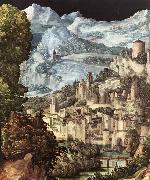All Albrecht Durer Oil Paintingsb.May 21, 1471, Imperial Free City of N??rnberg [Germany] d.April 6, 1528, N??rnberg |
|||
 |
|||
|
|
|
||||||||||
|
|
||||||||||
|
Portrait of Oswolt Krel Gemälde IDENTIFIZIERUNG:: 63737 |
Portrait of Oswolt Krel 1499 Oil on panel, 50 x 39 cm (central), 50 x 16 cm (each side panel) Alte Pinakothek, Munich Inscription in the top left by someone else (?): OSWOLT KREL 1499. This portrait comes from the collection of the Princes Oettingen-Wallerstein, who had acquired it in 1812; if has been in its present location since 1928. It is presumed that Oswolt Krell, a merchant for the Ravensburg House in Nuremberg from 1495 to 1503, had asked the artist for a true portrait of representation. Its notable size, similar to that adopted by D?rer for the portrait of his father two years earlier, and its setting, a half-length, suggests this. In this way, it differs from the Tucher portraits, which were intended for private use. The background, as in the Tucher portraits (Schlossmuseum, Weimar), is divided between the curtain and landscape passage, unlike those, however, it is divided rather unevenly. The bright red curtain is wide and occupies most of the space on the right; the landscape, on the left, is reduced to a foreshortening that shows a small part of a river that meanders toward the back, behind a group of tall trees. The windowsill that separated the subject from the landscape in the Tucher paintings is absent. The figure represented, set with obvious grandiosity, is found in front of the curtain, highlighted by intense colour. The large fur-lined cloak is casually placed on the right shoulder only, to show, on the left side, the rich black garment with the puffed sleeve. To the disorderly folds of the cloak correspond the parallel horizontal folds of the sleeve and the vertical ones of the garment. The three-quarter position allows the painter to bring out the quality of the attire: the fur, silk shirt, and gold chain. The careful, fastidious representation of these meaningful details creates a powerful foundation for the setting of the head: vigorous, strong features, the pronounced nose and the strong-willed mouth, the furrowed eyebrows, as if from a sudden start or fright that makes him direct his gaze off to the side behind him. Everything works to make his face threateningly severe, which even the soft, light brown hair framing him does not attenuate. To the energetic expression of the face corresponds the nervous look of his left hand clutching his cloak and that of the contraction of the knotted fingers of the right hand that leans on an invisible window sill. Colour, form, and proportion heighten the expression of supreme resolution, an expression that is the result of a serious psychological study that D?rer conducted on the merchant, who was the same age as the artist and who was later to become the mayor of Lindau, his native city. The two side panels that represent two "sylvan men" are wings to the portrait. They bear the heraldic shields of the subject and his wife, Agathe von Esendorf. They originally let the portrait be closed from the retro; one could imagine, then, that despite the large dimensions, the painting was to be conserved closed. The present frame has been made recently.Artist:D?RER, Albrecht Title: Portrait of Oswolt Krel Painted in 1501-1550 , German - - painting : portrait 1499 Oil on panel, 50 x 39 cm (central), 50 x 16 cm (each side panel) Alte Pinakothek, Munich Inscription in the top left by someone else (?): OSWOLT KREL 1499. This portrait comes from the collection of the Princes Oettingen-Wallerstein, who had acquired it in 1812; if has been in its present location since 1928. It is presumed that Oswolt Krell, a merchant for the Ravensburg House in Nuremberg from 1495 to 1503, had asked the artist for a true portrait of representation. Its notable size, similar to that adopted by D?rer for the portrait of his father two years earlier, and its setting, a half-length, suggests this. In this way, it differs from the Tucher portraits, which were intended for private use. The background, as in the Tucher portraits (Schlossmuseum, Weimar), is divided between the curtain and landscape passage, unlike those, however, it is divided rather unevenly. The bright red curtain is wide and occupies most of the space on the right; the landscape, on the left, is reduced to a foreshortening that shows a small part of a river that meanders toward the back, behind a group of tall trees. The windowsill that separated the subject from the landscape in the Tucher paintings is absent. The figure represented, set with obvious grandiosity, is found in front of the curtain, highlighted by intense colour. The large fur-lined cloak is casually placed on the right shoulder only, to show, on the left side, the rich black garment with the puffed sleeve. To the disorderly folds of the cloak correspond the parallel horizontal folds of the sleeve and the vertical ones of the garment. The three-quarter position allows the painter to bring out the quality of the attire: the fur, silk shirt, and gold chain. The careful, fastidious representation of these meaningful details creates a powerful foundation for the setting of the head: vigorous, strong features, the pronounced nose and the strong-willed mouth, the furrowed eyebrows, as if from a sudden start or fright that makes him direct his gaze off to the side behind him. Everything works to make his face threateningly severe, which even the soft, light brown hair framing him does not attenuate. To the energetic expression of the face corresponds the nervous look of his left hand clutching his cloak and that of the contraction of the knotted fingers of the right hand that leans on an invisible window sill. Colour, form, and proportion heighten the expression of supreme resolution, an expression that is the result of a serious psychological study that D?rer conducted on the merchant, who was the same age as the artist and who was later to become the mayor of Lindau, his native city. The two side panels that represent two "sylvan men" are wings to the portrait. They bear the heraldic shields of the subject and his wife, Agathe von Esendorf. They originally let the portrait be closed from the retro; one could imagine, then, that despite the large dimensions, the painting was to be conserved closed. The present frame has been made recently.Artist:D?RER, Albrecht Title: Portrait of Oswolt Krel Painted in 1501-1550 , German - - painting : portrait |
|||||||||
|
|
||||||||||
|
|
Adoration of the Magi Gemälde IDENTIFIZIERUNG:: 63739 |
Adoration of the Magi 1504 Oil on wood Galleria degli Uffizi, FlorenceArtist:D?RER, Albrecht Title: Adoration of the Magi (detail) Painted in 1501-1550 , German - - painting : religious 1504 Oil on wood Galleria degli Uffizi, FlorenceArtist:D?RER, Albrecht Title: Adoration of the Magi (detail) Painted in 1501-1550 , German - - painting : religious |
||||||||
|
|
||||||||||
|
|
Emperor Charlemagne Gemälde IDENTIFIZIERUNG:: 63740 |
Emperor Charlemagne 1512 Oil on lindenwood, 188 x 87,6 cm Germanisches Nationalmuseum, Nuremberg The idealized portrait of Emperor Charlemagne was intended for the "Heiltumskammer" in the Schoppersche House by the marketplace, together with the portrait of Emperor Sigismund of Poland (also in Nuremberg). This was where the coronation insignia and relics were kept, which were put on display once a year at the so-called "Heiltumsweisungen." The physiognomy of Charlemagne, shown in the magnificent original coronation robes, is reminiscent of depictions of God the Father. The crown, sword and imperial orb were prepared by D?rer in sketches. The German imperial coat of arms and French coat of arms with the fleur-de-lis are emblazoned at the top.Artist:D?RER, Albrecht Title: Emperor Charlemagne Painted in 1501-1550 , German - - painting : portrait 1512 Oil on lindenwood, 188 x 87,6 cm Germanisches Nationalmuseum, Nuremberg The idealized portrait of Emperor Charlemagne was intended for the "Heiltumskammer" in the Schoppersche House by the marketplace, together with the portrait of Emperor Sigismund of Poland (also in Nuremberg). This was where the coronation insignia and relics were kept, which were put on display once a year at the so-called "Heiltumsweisungen." The physiognomy of Charlemagne, shown in the magnificent original coronation robes, is reminiscent of depictions of God the Father. The crown, sword and imperial orb were prepared by D?rer in sketches. The German imperial coat of arms and French coat of arms with the fleur-de-lis are emblazoned at the top.Artist:D?RER, Albrecht Title: Emperor Charlemagne Painted in 1501-1550 , German - - painting : portrait |
||||||||
|
|
||||||||||
|
|
Lamentation for Christ Gemälde IDENTIFIZIERUNG:: 63741 |
Lamentation for Christ 1500-03 Oil on panel Alte Pinakothek, Munich This scene is framed above by a beautiful landscape in which Jerusalem can be seen off the lakeshore, atop a hill, in the foreground. Behind the city is a mountain peak and a mountain range that disappear into the background. The city, mountains, and lake are flooded with light. A thick blanket of heavy black clouds that thins out just above the lake in the back looms over the mountains. While the presence of the black clouds is justified by the narration of the crucifixion ("and darkness came over the whole land...while the sun's light failed," Luke 23:45), and the light is explained by the words of the apocryphal gospel of Saint Peter when he describes the position ("and the sun began to shine again ", 6:21), the Jerusalem that appears in the painting - a city near water, with house, towers, and fortification walls, lying against rocky mountains - is decidedly an invented, Nordic city, which does not at all reflect the actual appearance, well known at that time, of this blessed city.Artist:D?RER, Albrecht Title: Lamentation for Christ (detail) Painted in 1501-1550 , German - - painting : religious 1500-03 Oil on panel Alte Pinakothek, Munich This scene is framed above by a beautiful landscape in which Jerusalem can be seen off the lakeshore, atop a hill, in the foreground. Behind the city is a mountain peak and a mountain range that disappear into the background. The city, mountains, and lake are flooded with light. A thick blanket of heavy black clouds that thins out just above the lake in the back looms over the mountains. While the presence of the black clouds is justified by the narration of the crucifixion ("and darkness came over the whole land...while the sun's light failed," Luke 23:45), and the light is explained by the words of the apocryphal gospel of Saint Peter when he describes the position ("and the sun began to shine again ", 6:21), the Jerusalem that appears in the painting - a city near water, with house, towers, and fortification walls, lying against rocky mountains - is decidedly an invented, Nordic city, which does not at all reflect the actual appearance, well known at that time, of this blessed city.Artist:D?RER, Albrecht Title: Lamentation for Christ (detail) Painted in 1501-1550 , German - - painting : religious |
||||||||
|
|
||||||||||
| VORHERIGER KÜNSTLER NÄCHSTER KÜNSTLER | ||||||||||
|
|
||||||||||
| Albrecht Durer | ||||||||||
| b.May 21, 1471, Imperial Free City of N??rnberg [Germany] d.April 6, 1528, N??rnberg | ||||||||||
|
|
||||||||||
|
KONTAKTIEREN Sie UNS |









